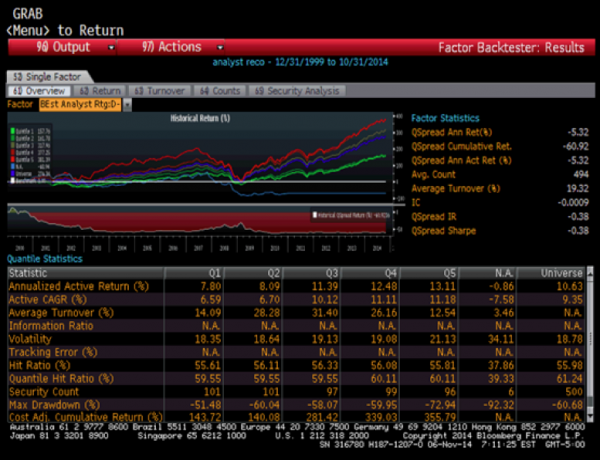The cycle is all too familiar to financial advisors. First, the “talking head” on television recommends a stock. This is in turn seen by a client as they are having lunch at the local diner. That’s followed by the phone call to their advisor asking for their hard earned money to be invested in that stock because they “heard that analyst X from firm Y says it’s a buy!” This scenario plays out thousands of times each day with investors feeling like they are getting into a stock ahead of the curve based on an expert’s analysis with the expectation that they will make money on the deal (or getting out of a stock before they lose money). That said, the question really is, do analyst recommendations drive the performance of stocks?
Reality Shares recently looked at the total return performance of stocks as measured by the investment recommendations assigned from the equity research analysts who track such stocks. Each day, billions of dollars are invested by mutual funds, pension funds, and other investors based on the advice of these analysts. On the surface one would expect such expert views to provide valuable information to help investors gain extraordinary returns. But the data seems to indicate otherwise.
Analysts usually assign a Buy, Hold or Sell recommendation on the stocks they follow. This investment recommendation is the summary of their analysis and represents the strength of their conviction on the stock as an investment. It is derived through analysis on a myriad of inputs from company reports, earning calls, company visits, conversations with management, etc., and is supported by analyst’s proprietary financial models and industry comparisons.
When individual investment recommendations for a particular covered company are aggregated from multiple analysts by third-party distributors, a ‘consensus rating’ is created. Financial data providers like Bloomberg, Reuters, etc., aggregate these investment recommendations to derive a combined opinion which can be thought of as the collective expert view on the stock. Bloomberg converts these individual investment recommendations into numbers and aggregates the numbers to give a consensus investment rating. These ratings range from 5 (a perfect Buy) to 1(a perfect Sell).
To test the efficacy of analyst recommendations to stock performance Reality Shares conducted research using the ‘FTST’ function in Bloomberg. ‘FTST’ looks at the historical stock performance based on a factor, or in this case the consensus investment recommendation for the individual stocks in the S&P 500 index. In ‘FTST,’ the selected stock universe is divided into 5 buckets (quintiles) based on the factor. The top bucket contains the stocks ranking highest on the factor and the bottom bucket holds those stocks with the lowest ranking. The average returns are then calculated on the stocks in all of the buckets. We selected the S&P 500 constituents as our sample universe to specifically exclude small & midcap stocks. The time period starting from 31st Dec 1999 – 31st Oct 2014 ensured that we covered a sufficient number of stock market cycles. The data used was historical point-in-time to avoid look-ahead bias, and included monthly rebalances. The results were surprising and contrary to conventional wisdom.

Our Findings
Our research suggests stock returns seem to move in the opposite direction of the consensus analyst investment recommendations, with the top quintile (stronger buy ratings) delivering the lowest returns with the bottom quintile (stronger sell ratings) delivering the highest returns. Over the entire spectrum, the average investment returns gradually go down as we move to the top quintile. While these results seem counterintuitive, on reflection it may not seem so curious when statistics prove how many active mutual fund managers, who are major clients of equity research analysts, also underperform their passive stock benchmarks over time. This trend of underperformance has led to the exponential growth of index funds.
So what can explain this disconnect between the conviction of investment recommendation and stock performance? That’s a topic for another day, but it begs the question – how expert are the experts?
Tom Trivella is Chief Administrative Officer & Chief Compliance Officer at Reality Shares, Inc. an index and research firm based in San Diego, CA.

